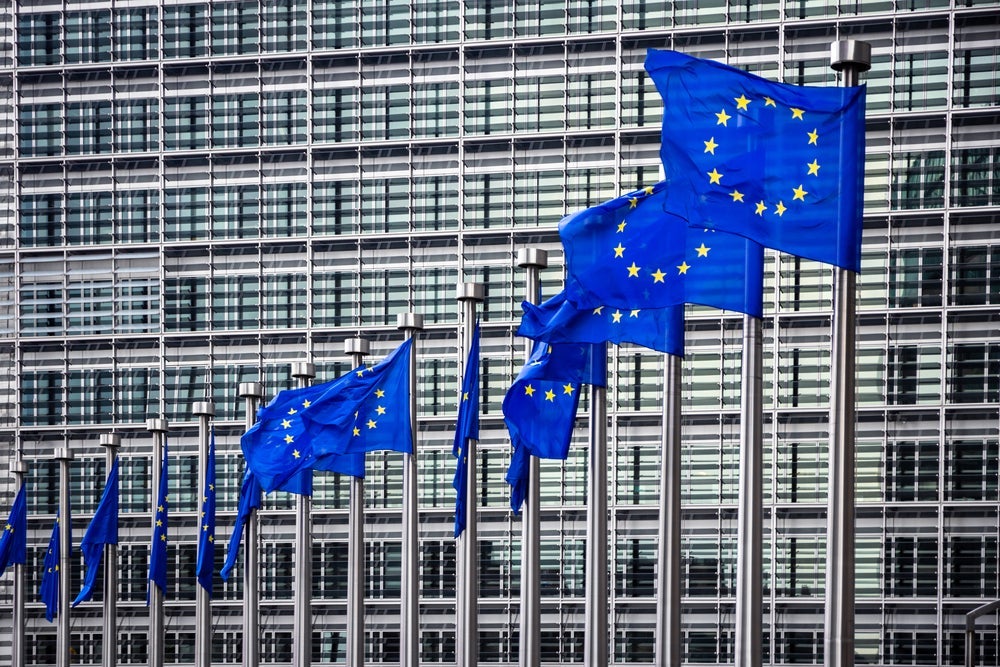
The EU is a unique economic and political partnership between 27 European countries – Austria, Belgium, Bulgaria, Croatia, Cyprus, the Czech Republic, Denmark, Estonia, Finland, France, Germany, Greece, Hungary, Ireland, Italy, Latvia, Lithuania, Luxembourg, Malta, the Netherlands, Poland, Portugal, Romania, Slovakia, Slovenia, Spain and Sweden.
Its predecessor – the European Economic Community – was created in 1957 to foster trade between its six founding members and maintain lasting peace and prosperity. Since then, the union has expanded significantly and evolved into an organisation across several policy areas including health, the environment, justice and migration. Its name was changed to the EU in 1993 to reflect this.
In addition, the EU single market enables most goods, services, money and people to move freely. Overall, EU gross domestic product (GDP) reached $17.1trn in 2021, accounting for 17.8% of the global economy.
The UK became the first member state to leave the EU in 2020. Several countries are currently negotiating to join the union, with Albania, North Macedonia and Turkey among the candidate countries.
Germany accounts for one-quarter of the EU economy
Germany is the largest EU economy representing one-quarter of the union’s overall GDP in 2021. The country has the highest GDP in Europe and the fourth-highest worldwide. In addition, it is Europe’s largest manufacturing economy and one of the world’s largest exporters – with vehicles, machinery, chemicals, electronics and pharmaceuticals among its top products.
The country experienced a three-year decline in GDP between 1999 and 2001 driven by weak consumer spending and low investment. The economy began to recover in 2002 and grew consistently until 2009 when GDP dropped by 8.9% over the year in the fallout from the global recession.
In the early to mid-2010s, GDP fluctuated. The economy contracted in 2012 and 2015 amid the eurozone debt crisis. Between 2016 and 2018, GDP increased year on year, culminating in a record employment rate and budget surplus.
However, a slowdown in global trade prompted by the US-China trade war and uncertainty surrounding Brexit led to a 2.2% drop in GDP between 2018 and 2019.
Following the onset of Covid-19, the economy contracted by a modest 1.1% in 2020. In 2021, GDP surged by 9.8% and exceeded pre-pandemic levels to reach a record $4.2trn (€4.27trn).
France is the EU’s second-largest economy, accounting for 17.2% of overall GDP in 2021. Tourism, manufacturing and pharmaceuticals are among the country's leading economic sectors. Approximately 89.4 million tourists travel to France annually, making it the most-visited country in the world.
The country saw a 2.2% decline in GDP in 2019 following a fall in inventories and a slowdown in household spending. Consumption was also heavily impacted towards the end of year amid nationwide strikes against President Emmanuel Macron’s pension reform.
In 2020, the economy contacted by 3.6% in the wake of Covid-19 before soaring by 11.7% the next year thanks to a rapid vaccination roll-out and robust public support measures. The Bank of France projects GDP will grow by 2.6% in 2022 followed by an estimate between -0.5% and 0.8% for 2023.
Italy is the third-largest EU country by GDP, which measured $2.1trn in 2021. It is Europe’s second-largest manufacturing economy with machine tools, vehicles, furniture and food products among its key products. Italy is also the largest wine producer in the world and Europe’s regional hub for luxury goods.
Covid-19 has had a devastating impact on the Italian economy. It was the first Western country to be hit by the virus in February 2020 and the first European country to introduce mass lockdown measures. The Italian economy contracted by 3.9% in 2019, and was already vulnerable when Covid struck, leading to a 5.9% decline in GDP in 2020.
Italy is set to be the largest recipient of the EU's Covid Recovery Fund and will receive approximately €200bn if it meets a series of reform targets. A dispute over how to spend the money led to the resignation of former Prime Minister Giuseppe Conte in early 2021.
The far-right Brothers of Italy party led by Giorgia Meloni won the country’s September 2022 general election. Meloni is expected to take office at the end of October 2022 and form Italy's most right-wing government since the Second World War.
Meloni has stated that she wants to reassess the reforms agreed with the EU for the post-Covid recovery grant to take the energy crisis into account. Italy is already the second most indebted country in the eurozone.
Malta is the smallest economy within the EU at $17.2bn in 2021. It became a member state in 2004 and part of the eurozone in 2008. The Maltese economy grew consistently between 2016 and 2019 before dropping by 5.1% in 2020. Its GDP increased by 15.2% in 2021 and far surpassed pre-Covid-19 levels thanks to improved investor sentiment and growth in services exports.
The country boasts a central location between Europe, North Africa and the Middle East as well as a multilingual population – around 88% of the population speaks English and roughly 66% speaks Italian. Malta’s economy is highly diversified with major industries ranging from advanced manufacturing and life sciences to ICT and aviation.
Luxembourg recorded the highest GDP per capita of all countries analysed at $135,683 in 2021. This is the third-highest figure globally behind Monaco and Liechtenstein. Luxembourg is a global hub for the financial services industry and home to over 123 international banks from more than 26 countries.
Luxembourg also had the highest population growth rate in the EU at 1.4% in 2021, driven largely by immigration. Approximately 70% of the city of Luxembourg’s population is foreign-born, representing 167 different nationalities.
Croatia – which joined the EU in 2013 – had the lowest population growth of all countries analysed; at -3.7% in 2021, it was second only to Singapore globally. This can be attributed to the country’s low birth rate as well as the emigration of young people to more prosperous EU countries.
In the wake of Covid-19, Croatia experienced the steepest drop in GDP between 2019 and 2020 at -8.1%. In 2021, its economy also saw the largest increase at 18.6%, which the government credited to the recovery of the tourism industry, growth in exports in goods and services, and increased household spending.
Following Russia’s invasion of Ukraine, inflation has soared globally with energy, food and petrol and diesel prices rising sharply. According to the European Central Bank’s Harmonised Index of Consumer Prices, Estonia had the highest annual rate of change (25.2%) in August 2022. This is more than double the EU average of 12.4% and is partly due to Estonia’s strong rebound post-Covid leading to labour shortages and higher wages.
Latvia and Lithuania also had extremely high annual rates of change at 21.4% and 21.1%, respectively. During the same period, France had the lowest rate with 6.6%.
Ireland is the EU’s leading FDI destination per capita
According to the Global FDI Annual Report 2022, Germany overtook the US to become the world’s leading destination country for inbound foreign direct investment (FDI) in 2021. The country attracted 1,535 projects during the year – a 2% decline compared with 2020 levels. Despite the minor drop in inward German FDI between 2020 and 2021, it managed to outdo the US, which had a more significant decline of 11%.
The US was Germany’s main source country for investment, followed by France and the UK. Software and IT services was the top sector for German FDI, accounting for roughly 17% of projects in 2021. Other key sectors included electronics, communications and media, and business and professional services.
France was the EU’s second most popular FDI destination and fourth globally. The country recorded 768 inbound FDI projects in 2021, a 21.9% increase over the year and a 44.4% increase compared with pre-Covid-19 levels. Approximately 17% of France’s inward FDI was in the software and IT services sector, 11% in business and professional services, and 6% in the electronics and automotive industries.
Spain recorded the third-highest number of inbound FDI projects in the EU in 2021. It was also the sixth most popular FDI destination worldwide. The country attracted 639 FDI projects in 2021, growing 27.3% from 2020. However, FDI has yet to fully recover post-Covid-19 with investment levels 2.3% lower than 2019. Spain’s top FDI sector in 2021 was software and IT services followed by renewable and alternative power, and logistics.
Ireland was the EU’s top FDI destination per capita with 6.2 FDI projects per 100,000 people in 2021. The country has become a hub for several industries including technology, pharmaceuticals, financial services and business services. It boasts a competitive tax regime, a young and well-educated workforce, and is the eurozone’s fastest-growing economy.
Several prominent high-tech companies have established their European headquarters in the Silicon Docks area of Dublin, including Facebook, Google and LinkedIn. Post-Brexit, Ireland has also secured several financial services projects from companies looking to relocate to maintain EU access. These include JP Morgan, Bank of America and Citi.
Finland ranked second for FDI per capita with 3.3 projects per 100,000 people. Approximately one-quarter of Finnish inbound FDI was in the communications and media sector in 2021, followed by software and IT services (13.3%), business and professional services (9.9%) and construction and real estate (9.4%).
Germany, France and Sweden were the top EU countries for outbound FDI in 2021. The number of outbound Swedish FDI projects soared by 63% in 2021 compared with the previous year. This surge was largely driven by multinational telecommunications company Telia, which established more than 180 FDI projects during the year. Most of these investments were focused on Telia’s 5G roll-out across Estonia, Finland and Norway.
Denmark and Finland are the world’s least corrupt countries
Denmark, Estonia and the Netherlands tie for the shortest time on average to start a business in the EU at three-and-a-half days.
Denmark’s business environment is known for trust and openness, with a flexicurity model that makes it easy to hire staff and let them go if business needs change. The country’s taxation system, while higher than other countries across the EU, is simple to understand.
Estonia is extremely open to foreign investment, particularly in sectors focused on exports, innovation or that support regional development. It is also the first country to offer e-residency – a programme that allows entrepreneurs to set up a business in Estonia remotely and provides access to the country’s e-services and business environment.
The Netherlands also offers a competitive business climate and boasts a central location, well-developed connectivity links, and a highly educated and skilled workforce.
The country offers several incentives to encourage innovation and sustainable investments, including a research and development (R&D) tax credit that compensates companies for part of their R&D wage costs and expenditures; and the Energy Investment Allowance, which allows companies to offset 45.5% of their investments in energy-efficient technologies against their personal or corporate income tax.
Luxembourg had the highest share of its population using the internet in 2020 at 98.8%. Technology and e-commerce are among Luxembourg’s key economic sectors and the country boasts extremely well-developed, high-speed communications infrastructure and multiple data centres. Bulgaria and Italy had the lowest share of individuals using the internet with 70.2% and 70.5%, respectively. The EU average is 86.3%.
Denmark and Finland topped Transparency International’s 2021 edition of the Corruption Perception Index. Both countries scored 88 out of 100, alongside New Zealand.
Finland’s openness to trade and foreign investment makes it an ideal location to do business. The country offers political stability, government transparency, a talented workforce and world-class technology and innovation. In addition, foreign companies are eligible for a wide range of government incentives in the areas of taxation, training and employment, land and infrastructure, and R&D funding.
Bulgaria is the most corrupt EU country with a score of 42 in 2021 and ranks 78th out of 180 nations. Transparency International attributes this score to the country using Covid-19 as an excuse for delaying anti-corruption efforts. Hungary and Romania follow shortly behind with scores of 43 and 45.
Hungary has the lowest corporation tax rate in the EU at 9% in 2021, with Bulgaria a close second at 10%. In June 2022, Hungary blocked an EU directive to enforce a 15% minimum tax on multinational corporations with an annual revenue of more than €750m, claiming that the plans will hamper its investment attractiveness. The tax reform is part of a global deal achieved in 2021 by the OECD.
Malta has the highest corporation tax rate in the EU at 35%. However, this figure is much less in practice for international businesses as shareholders can receive a tax refund of up to six-sevenths of their tax paid in Malta, resulting in a corporation tax rate of as little as 5%.
Which EU country has the best quality of life?
The Czech Republic had the lowest unemployment rate across the EU in 2021 at 2.9%. However, economists have warned that this figure could be due to a shortage of workers. Conversely, Greece had the highest rate of unemployment at 14.8%.
Luxembourg had the lowest age dependency ratio in the EU – the ratio of dependents to working age population – at 43.4% in 2021. Cyprus (45.3%), Slovakia (48.8%) and Austria (51.4%) also had the low ratio, below the EU average of 55.8%.
Malta has the highest life expectancy among the EU member states at 82.7 years on average in 2020, although it should be noted that seven countries are within the same year (Finland, France, Ireland, Italy, Spain and Sweden). The EU average is 79.6 years.
Ireland has the highest tertiary attainment rate out of all the countries analysed. More than 52% of 25–64-year-olds have a third-level education. This is well above the EU average of 33.4%.
Which EU countries lead for environmental friendliness?
Germany was responsible for more than 650,000 kilotonnes of carbon emissions in 2019, making it the biggest emitter in the EU and the sixth largest worldwide. However, this is a 31.2% drop from emission levels in 1990.
Germany was also the EU’s largest producer of renewable electricity with 250,154 gigawatt hours in 2020, accounting for approximately one-quarter of the overall regional figure. Under the Climate Action Programme 2030, the German government is aiming to reduce greenhouse gas emissions by 55% by 2030 and phase out the use of coal to generate electric power.
In terms of indexed growth, Cyprus experienced the largest increase in carbon emissions while Estonia had the largest decline.
Denmark ranked first with a score of 77.9 out of 100 on the Yale Centre for Environmental Law & Policy’s 2022 Environmental Performance Index (EPI), which assesses 180 countries on their climate change performance, environmental health and ecosystem vitality.
Portugal ranked the worst among the EU nations with a score of 50.4 – Poland was just ahead with a rating of 50.6. Both countries scored particularly low in the Climate Policy category.
Malta had the most improved EPI score in the EU. It scored 75.20 in the 2022 edition of the index, a 25.4-point improvement over the previous ten years. Malta also had the highest indexed growth in renewable electricity production between 2006 and 2020.
In addition, Belgium improved its EPI score by 6.1 points during this period due to enhanced ecosystem protection and resource management. Slovenia also boosted its score by 8.6 points due to improvements in how well the country is protecting its residents from environmental health risks and further developments in its climate policy.







